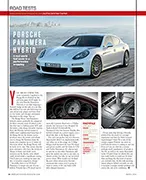
Porsche Panamera Hybrid
A real-world fuel saver in a performance wrapping You might think the same comments I applied to the Range Rover Hybrid on the previous page could apply to the new…
Among its many credits, there’s also a strong suggestion the Zerex Special had a big part to play in the creation of one of motor racing’s all-time great formulas – Can-Am.
The Canadian-American racing series for big-capacity, big-power sports cars ran from 1966-1987. But the idea and the formula was developed from the type of car that began seeping into Group 7 sports car racing from 1964, right when the Zerex was the benchmark.
When Bruce McLaren bought the car, along with the Traco-Oldsmobile V8, from the Mecom workshops and set about fitting a unit with more bulk and power than the original chassis could handle, it set the tone firmly for Can-Am.
“The fourth iteration of the Zerex Special is actually the first-ever McLaren,” says Heacock. “He cut it up, built his own chassis and fitted a huge engine. It’s basically a ‘McLaren M1-minus-1’. If you look at the Can-Am cars from the 1970s they were basically single-seaters with huge engines and big air scoops either side of the driver. It’s funny to look at this car from 1962 and see the same trend. It’s not as wide, but the Zerex definitely fits into the puzzle of Can-Am’s early days.
“The car must have been terrifying when Bruce put that 3.5-litre unit in the back. That must have been about 500bhp in a car weighing no more than 1200 pounds. I’ve had conversations with people who saw it race like that and I reckon Bruce was absolutely fearless – and at that time he probably believed he was indestructible, too. But those guys back then were like that. Roy would tell me most would race a car with three lug nuts out of five, just because if the wheel was still on it would probably be OK. There was no health and safety back then. It was pretty insane. But the development of the Zerex just shows how much motor racing changed across those few years
in the 1960s.”